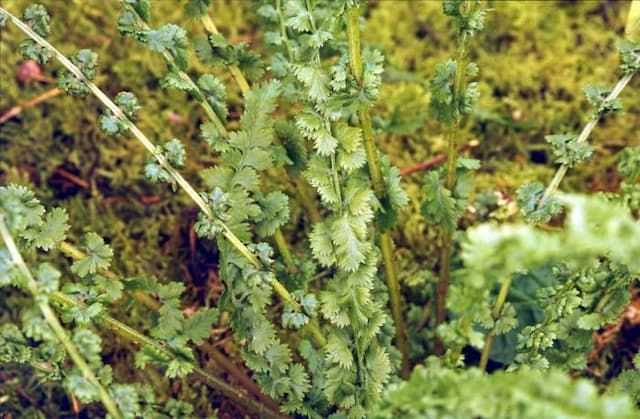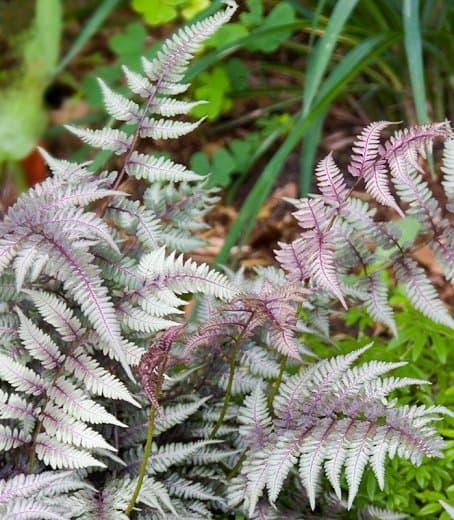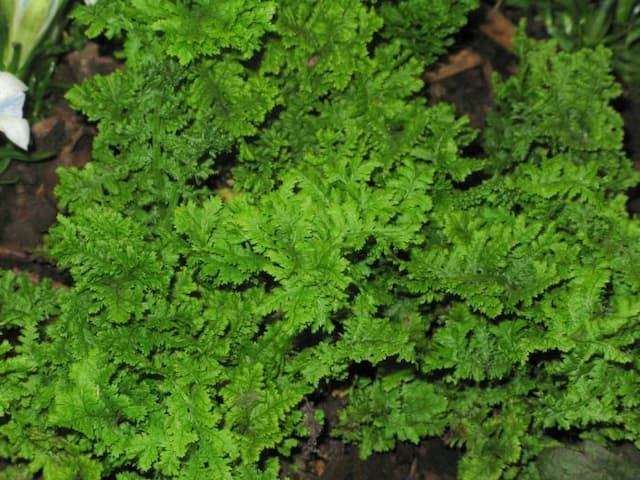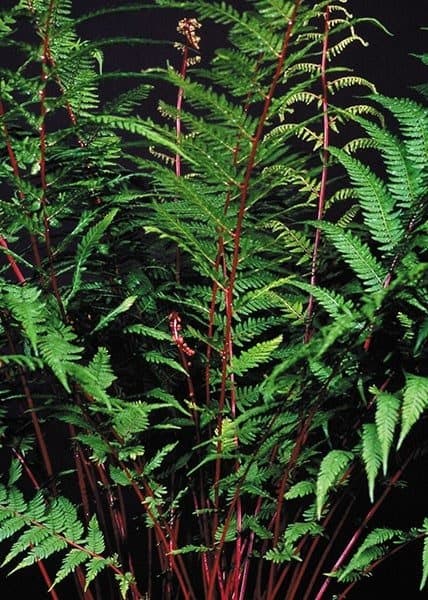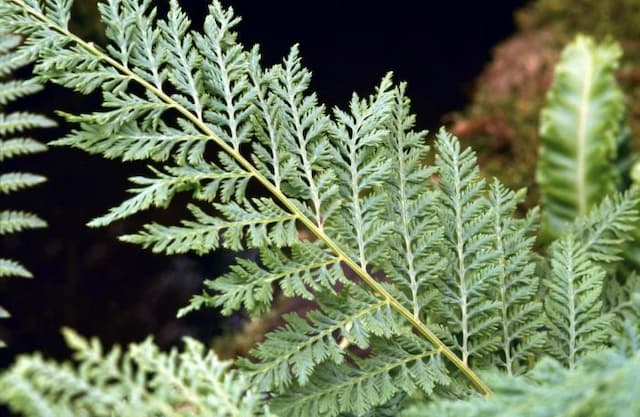Japanese Painted Fern Athyrium niponicum var. pictum

ABOUT
Japanese painted fern is known for its visually striking appearance that adds a touch of elegance to shady garden spots. The leaves, called fronds, have a soft, feathery texture and are the most distinctive feature of this elegant plant. Each frond arches gracefully, displaying a beautiful tapestry of colors. They typically flaunt a blend of silver, green, and burgundy, with the silver color casting a metallic sheen that contrasts sharply with the deeper hues beneath. The central stem of each frond, commonly referred to as the stipe or rachis, often exhibits a reddish-purple color which further accentuates the intricate variegated patterns on the leaflets. These leaflets are arranged in a ladder-like fashion on either side of the stem, contributing to the delicate and layered visual effect that makes the Japanese painted fern a sought-after ornamental plant. The overall impression is one of subtle color and fine texture, making it a popular choice for gardeners seeking to create a serene and attractive shade garden.
About this plant
 Names
NamesFamily
Athyriaceae.
Synonyms
Japanese Painted Fern, Pictum Fern, Silver Falls Japanese Fern, Metallic Fern.
Common names
Athyrium goeringianum, Athyrium nipponicum.
 Toxicity
ToxicityTo humans
The common name for Athyrium niponicum var. pictum is the Japanese Painted Fern. This plant is generally considered non-toxic to humans. Therefore, there are no specific symptoms of poisoning or toxic consequences associated with ingesting any part of the Japanese Painted Fern.
To pets
The common name for Athyrium niponicum var. pictum is the Japanese Painted Fern. This fern is also typically non-toxic to pets, which means that it is not expected to cause poisoning in animals like cats and dogs. As a result, there are no known toxic effects or symptoms associated with ingestion of this plant by pets.
 Characteristics
CharacteristicsLife cycle
Perennials
Foliage type
Deciduous
Color of leaves
Mixed
Height
1 foot 6 inches (45 cm)
Spread
2 feet 0 inches (60 cm)
Plant type
Fern
Hardiness zones
4
Native area
Japan
Benefits
 General Benefits
General Benefits- Aesthetic Appeal: The Japanese painted fern, with its silver-grey fronds and hints of red and blue, adds visual interest and a splash of color to shade gardens.
- Easy to Grow: This fern is relatively easy to care for and can thrive in a variety of soil types, though it prefers a moist, well-draining environment.
- Ground Cover: Its dense growth habit makes it an excellent ground cover for shady areas, helping to suppress weeds and maintain soil moisture.
- Wildlife Habitat: It provides shelter and habitat for small wildlife and insects, contributing to biodiversity in the garden.
- Drought Tolerance: Once established, it exhibits a degree of drought tolerance, reducing the need for frequent watering.
- Seasonal Interest: Its foliage can offer seasonal interest from spring to fall, with changing hues throughout the growing season.
- Companion Planting: Japanese painted ferns work well in combination with other shade-loving plants such as hostas and astilbes, creating appealing textures and contrasts.
- Low Maintenance: It requires minimal maintenance once established, with no need for pruning and little susceptibility to pests and diseases.
 Medical Properties
Medical PropertiesThis plant is not used for medical purposes.
 Air-purifying Qualities
Air-purifying QualitiesThis plant is not specifically known for air purifying qualities.
 Other Uses
Other Uses- Japanese Painted ferns can be used in terrariums or fairy gardens to create a lush, miniature landscape due to their smaller size and decorative foliage.
- The fronds of Japanese Painted fern are sometimes used in floral arrangements to add delicate texture and a subtle hint of color.
- As a subject for botanical art or photography, the Japanese Painted fern's intricate patterns and colors offer a unique aesthetic appeal.
- In cooler climates, the Japanese Painted fern can be grown indoors as an ornamental houseplant, adding a touch of natural beauty to interior spaces.
- Gardeners might use the Japanese Painted fern in shade gardens for educational purposes, such as demonstrating plant adaptation in low-light conditions.
- Japanese Painted fern can serve as host plants for various species of butterflies and moths, offering a source of nutrition in their larval stages.
- In craft projects, the fronds of Japanese Painted fern can be pressed and preserved in glass frames to create natural and decorative wall art.
- Groundcovers like Japanese Painted fern can be used under larger plants or trees to prevent soil erosion in shaded garden areas.
- Japanese Painted ferns can be planted in containers with wheels to create mobile shade spots that can be moved around in a landscape to protect other sun-sensitive plants.
- Japanese Painted fern can be utilized in sensory gardens to provide a tactile experience with its soft fronds, especially engaging for children and visually impaired visitors.
Interesting Facts
 Feng Shui
Feng ShuiThe Japanese painted fern is not used in Feng Shui practice.
 Zodiac Sign Compitability
Zodiac Sign CompitabilityThe Japanese painted fern is not used in astrology practice.
 Plant Symbolism
Plant Symbolism- Elegance: The Japanese painted fern (Athyrium niponicum var. pictum) is often associated with elegance due to its delicate, silvery-grey fronds with hints of blue and purple.
- Subtlety: Its understated beauty makes it a symbol of subtlety and refinement, not overwhelming but rather enhancing its surroundings with gentle grace.
- Creativity: The unique coloration and variegated leaves of the Japanese painted fern signify creativity, representing the diversity and imagination found in nature.
- Serenity: Associated with peaceful and shady gardens, this fern can symbolize serenity and the calming influence of a quiet, natural space.
- Resilience: Despite its delicate appearance, the Japanese painted fern is quite hardy, representing resilience and the ability to thrive in various conditions.
 Water
WaterJapanese Painted Ferns require consistent moisture and should never be allowed to completely dry out. Water the fern deeply once a week with about half a gallon per plant, making sure to soak the soil around the roots. During the hotter months or in drier climates, you may need to water twice a week. Adjust the frequency based on rainfall, as over-watering can be as detrimental as under-watering. Ensure there is proper drainage to prevent water logging which can lead to root rot.
 Light
LightJapanese Painted Fern thrives in partial to full shade. The ideal spot for this plant is one that receives morning light with protection from the intense afternoon sun. The delicate fronds can scorch with too much exposure, so a location under the dappled shade of a tree or on the north side of a building would be ideal.
 Temperature
TemperatureJapanese Painted Fern prefers temperatures between 60°F and 75°F but can tolerate a range from 50°F to 80°F. It's not frost-tolerant and should be protected from temperatures below 50°F. During extreme heat, ensure the fern has adequate shade and moisture to prevent stress.
 Pruning
PruningJapanese Painted Fern doesn't usually require extensive pruning. Remove any dead or damaged fronds in the spring to encourage new growth and maintain aesthetics. Pruning can be done as needed throughout the season to keep the plant looking tidy. The best time for any major trimming is early spring before new fronds emerge.
 Cleaning
CleaningAs needed
 Soil
SoilJapanese painted fern prefers a well-drained soil rich in organic matter, with a pH range of 5.5 to 6.0. A good mix can be made of equal parts garden soil, peat moss, and perlite to ensure proper drainage and aeration.
 Repotting
RepottingJapanese painted ferns do not need to be repotted often; every 3-4 years or when they outgrow their current container is sufficient.
 Humidity & Misting
Humidity & MistingJapanese painted fern thrives in high humidity environments, ideally between 60% to 80%.
 Suitable locations
Suitable locationsIndoor
Place in bright, indirect light with high humidity and cool temperatures.
Outdoor
Grow in part to full shade and moist, well-drained soil.
Hardiness zone
4-9 USDA
 Life cycle
Life cycleThe Japanese Painted Fern (Athyrium niponicum var. pictum) starts its life as a spore, which requires moist, shaded conditions to germinate. The spore develops into a prothallus, a small, heart-shaped gametophyte that houses the reproductive organs. Upon fertilization, the prothallus gives rise to a young fern, the sporophyte, which is the familiar leafy plant. This fern grows by unfurling coiled fronds, or fiddleheads, which mature into the characteristically silver-painted and variegated fronds of the mature plant. As the fern ages, it produces sori on the underside of the fronds, which are clusters of sporangia where spores are produced, completing the life cycle when these spores disperse to new locations. With proper conditions, the Japanese Painted Fern can live for several years, going through multiple growth cycles of foliage production in spring and dormancy in winter.
 Propogation
PropogationPropogation time
Spring to Summer
The Japanese Painted Fern, Athyrium niponicum var. pictum, is usually propagated by division. The ideal time for this is in the spring when the plant is just beginning to grow. To propagate by division, the gardener should carefully lift the fern from the ground, ensuring to keep as many roots intact as possible. Next, using a sharp knife or spade, the root ball is divided into smaller sections, each with a part of the rhizome and several fronds. These sections should then be replanted promptly at the same soil level they were growing at before, and watered thoroughly. It's important to maintain consistent moisture around the newly planted divisions until they establish themselves, which may take several weeks to a few months.
